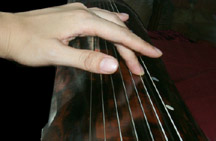|
The Guqin is a Chinese musical instrument, also called a seven-stringed zither. It has existed in Chinese culture for 3000 years, and was the favorite instrument of the literary class. For playing guqin, the finger technique is of the highest importance. Guqin has a unique system of notation all its own. Each note is written in abbreviated Chinese characters, so called "Jian-Zi." This site is about how to read notation for playing the Guqin. Here is one example  , readed as "Da Zhi Qi Hui Tiao Wu Shuan." It is a symbol that represents one note. This symbol means that you use your left thumb to press down the 5th string on the 7th Hui (dot) and use your right index finger to strum the 5th string.
For more detail explination of notation, please see Gu Qin Yin (Song of Gu Qin) Finger Technique Explanation. , readed as "Da Zhi Qi Hui Tiao Wu Shuan." It is a symbol that represents one note. This symbol means that you use your left thumb to press down the 5th string on the 7th Hui (dot) and use your right index finger to strum the 5th string.
For more detail explination of notation, please see Gu Qin Yin (Song of Gu Qin) Finger Technique Explanation. A, Notation of Strings Guqin has 7 strings, from farthest to nearest, from the thickest one to the thinnest one, this notation is represented by Chinese numbers from one to seven. 
B, The Different Types of Sound: Guqin has 3 kinds of sound: Fan Yin, An Yin and San Yin. Fan Yin (Harmonics) -Left fingers slightly touch the strings to stop the vibration played by right hand. The sound is light and bright. An Yin (Fundamental tone) -Left fingers press down the strings and the right hand plays. The sound is solid. San Yin (Open String)-without touching or press down the strings and the right hand plays. The sound is the nature sound (natural harmonics) of the whole strings. | |
 |
Notation: Name: San Yin (Loose)  Explanation: The left hand does not touch the strings. All the sound comes only from plucking or strumming by the right hand. When there is a continuing SanYin in one piece, the notation will only show in the first note and will omit it until the next type of sound shows up. Listen to this technique |
 |
Notation: Name: Fan Yin (Touch)  Explanation: 2 ways of Fan Yin: 1, The left hand fingers lightly touch the strings. At the same time, the right hand plucks or strums the strings so that it creates a very clear and crisp sound. 2, The left hand fingers are put on the correct Hui position but not touching the string and leaving about one rice space between the fingers and strings. At the same time, the right hand plucks or strums the strings so that the vibrating strings touch the left fingers to create Fan Yin. This is used in the situation that the right hand has to strum or pluck several strings to create continuing Fan Yin. (See Guenfu)  This notation indicates to start using Fan Yin. This notation indicates to start using Fan Yin. This notation indicates to stop using Fan Yin. This notation indicates to stop using Fan Yin."o" This notation is used above the simple note number to indicate that the note should be played using Fan Yin. Listen to this technique |
 |
Notation:  Name: An Yin (Press)  Explanation: An Yin is a solid sound. The left hand presses the strings down tightly and the right hand plucks or strums the strings. The notation of An Yin is usually omitted. The position of the left hand fingers on the Hui is the way to decide the sounds. Therefore, the notation of Hui position is the way to memorize the notes. Listen to this technique |
| C, Notation of Hui:
There are 13 Hui positions (marked by 13 dots on the body of the instrument) on the Qin from the right to the left, from one to thirteen. The notes are,  The distance between every two Hui is divided into 10 sections, with notes as  Examples of the combination of Hui notes:  This notation indicates the 3rd or 4th section above the 13th Hui. This notation indicates the 3rd or 4th section above the 13th Hui.
 This indicates the second section of the 6th Hui. This indicates the second section of the 6th Hui. This indicates the eight section of the 10th Hui. This indicates the eight section of the 10th Hui. | |